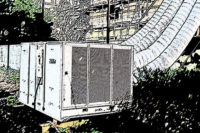This is a tall order, given the fact that many of the more than 133,000 public schools in the United States are show-ing their advanced age. The National Center for Education Statistics (NCES) reports that the average U.S. school building is 42 years old and that about three-fourths of all schools are more than 30 years old. U.S. schools are in such poor condition overall that the American Society of Civil Engineers gave them a “D” on its 2009 Report Card for America’s Infrastructure.
But help may be on the way. McGraw Hill and the National Clearinghouse for Educational Facilities (NCEF) say annual spending on new schools, additions, and alterations will double to about $70 billion by the middle of the decade. Much of that spending will go toward making improvements that save energy, reduce environmental im-pact and create a better learning environment. These include investments in HVAC retrofits.
Whether they are preparing for a major renovation, dealing with a short-term need, or covering the possibility of an unplanned system failure, school district facilities professionals are increasingly using rental equipment to meet their temporary HVAC needs.
The leading HVAC rental services companies provide their education customers with a wide range of new, state-of-the-art HVAC equipment. Rental equipment is usually modified with special framing, piping, and electrical fea-tures that make delivery, installation, and startup fast and efficient. Larger rental companies have equipment staged at various locations nationwide to respond quickly to their customers’ needs.
Managing Temporary Rental Solutions
An HVAC rental services company can help school facilities managers develop and implement plans to effectively meet their heating and cooling needs when their permanent systems are not available or cannot do the job, for whatever reason.According to the EPA, school districts spend about $205 on electricity and natural gas per year for each student in the system. New technology and other energy-efficiency measures can reduce energy use in the typical school by 30% to 40%. So it is no surprise that schools across the country are taking steps to reduce energy costs, including updating HVAC technology that is often decades old.
Large-scale HVAC retrofits can take weeks or even months to complete. It is not always possible to schedule work when school is not in session. Renting chilled water systems and components, cooling towers, rooftop air condi-tioners, air handlers, power generators, or other systems and equipment enables facilities managers to provide unin-terrupted service and ensure the comfort of students, teachers and staff during the renovation process.
For example, when school officials in Volusia County, FL, learned that the delivery of new chilled water systems for a high school and middle school would be delayed, they were able to quickly acquire four 400-ton air cooled water chillers from a leading HVAC rental services company so that students could start school on time.
Schools often choose to keep rental equipment on site even after a major HVAC renovation is completed to provide backup for the planned - and unplanned - interruptions that are a normal part of the commissioning and startup processes.
Temporary HVAC equipment can handle a school’s heating and cooling needs while scheduled maintenance is per-formed on its permanent system. With advance planning and preparation, rented solutions can be installed quickly and efficiently, giving technicians the time they need to service permanent systems without disrupting the school’s normal operations.
Rental solutions can also be useful for short-term dehumidification needs, such as controlling humidity in a specific area after painting, dry-wall installation, or hardwood floor refinishing.
Facilities managers often use rental solutions to meet seasonal cooling needs. For example, last summer a grade school in Kankakee, IL, rented two 35-ton rooftop A/C units to supplement the existing system and enhance the comfort of teachers and students during summer school sessions. A Tuba City, AZ, high school has rented a 400-ton air cooled water chiller and a generator for several years in a row to reduce the strain that the hot desert sun places on the school’s chilled water system during two of the hottest months of the year.
Rental companies often provide HVAC systems and electric generators for school special events, such as gradua-tions, proms, social gatherings, or sporting events. For example, rented systems can provide temporary heating or cooling to a field house not served by the school’s main HVAC system or to a tent in which a special event is being held.
Effective Rental Strategy is Key Element of Risk Management
The unplanned failure of an HVAC system can have an enormous financial and operational impact on a school. For starters, responding to an unplanned failure is always more expensive than performing scheduled service, given the higher cost of system repairs and equipment replacements made in a reactive mode.More costly still is the disruption that an unplanned system failure can have on day-to-day school operations. In the worst cases, an HVAC system failure means shutting down classrooms, common areas, or even an entire school for an extended period of time. The costs associated with salaries, lost instruction days and government funding, and a variety of other factors can easily eclipse actual repair or replacement costs. And that is before factoring in the cost and inconvenience to parents.
Even a less severe case can cause a loss of continuity and focus if administrators, teachers, and students spend time and attention focused on their discomfort rather than on education.
This is why many far-sighted school districts develop an HVAC system contingency plan as part of their overall emergency preparedness or risk management plan. An effective HVAC system contingency plan that includes cov-erage provided by an experienced and reliable rental services provider can minimize downtime and mitigate risk to the comfort, convenience, health and wellbeing of school building occupants.
A rental agreement included in a broader facilities management contract recently helped a Phoenix high school move quickly and efficiently to solve problems caused by a chilled water system breakdown that happened on a warm Arizona afternoon. After sending students and teachers home early, school officials and their energy service company (ESCO) partners jumped in to restore the school’s air conditioning system.
After determining that the system could not be repaired overnight, the facilities-ESCO team executed the HVAC contingency plan they had developed together just four months earlier. By the next morning HVAC rental service company emergency preparedness and installation specialists were on campus, a temporary chiller arrived by mid-afternoon, and installation was completed overnight. The school lost just one instruction day.
Preparation Pays Off for School Districts
Whether they are planning an HVAC system renovation or preparing to handle a worst-case system failure sce-nario, experienced school facilities managers know that preparation is essential. For most, that means working with an ESCO or emergency preparedness expert to develop a HVAC contingency plan.A well thought-out plan can dramatically reduce the time required to find, install, and start up a temporary HVAC system by making sure that all parties understand their roles and responsibilities. Advance planning and a standing agreement with a rental services company can reduce response time by two-thirds, which can mean getting a school’s HVAC system up and running in hours instead of days, or days instead of weeks.
Start-up delays and problems are also reduced because building and HVAC system modifications can be made in advance so rental chilled water systems, rooftop units, and other HVAC solutions can be installed and connected to the existing HVAC infrastructure quickly and efficiently. Creating an effective HVAC renovation or contingency plan includes four fundamental steps:
- Gathering and documenting key information. Information is collected about the school building and its current HVAC system. This is also the time to consider factors such as design specifications, current and antici-pated enrollment, climate conditions, recent and planned building alterations, and any special challenges or con-cerns.
- Analyzing and identifying needs. In the case of an HVAC renovation project, plans are reviewed with the goal of identifying where temporary heating and cooling capabilities will be needed to ensure continuous HVAC opera-tion before, during and after installation. For a contingency plan, an emergency preparedness specialist helps the facilities manager evaluate and rank potential HVAC system risks and what will be required to provide continuity during various types of emergencies.
- Developing recommendations. The facilities team and HVAC rental services specialist work together to rec-ommend a path forward, including suggesting facility modifications to prepare the school’s system for temporary heating and cooling. Performing these modifications in advance will reduce both cost and response time in the fu-ture.
- Drafting the plan. The HVAC contingency or continuity plan is drafted and, in many cases, is incorporated into the school’s more comprehensive crisis or renovation project plans. After the plan is approved by the administra-tion, school officials and the HVAC rental services company complete an agreement that spells out how they will work together to meet the school’s temporary equipment needs.
The temporary installation bought the school board the time it needed to analyze various options and make a well-informed decision on whether to repair or replace the existing system. Ultimately, the board purchased two new chillers, keeping the rental equipment for three months to provide operational continuity while the new system was delivered, installed, and started up.
HVAC Rental Provides Options for Facilities Managers
Like all of their colleagues in education, school facilities managers face a variety of challenges. Providing opera-tional continuity and ensuring the reliability of building systems – including HVAC systems - is the minimum standard.As school infrastructure continues to age, facilities professionals are challenged to keep older HVAC equipment running longer, with a tighter budget and without adversely affecting the indoor environment that directly impacts educational quality.
At the same time, they are charged with being thoughtful stewards of their school district’s resources by recom-mending infrastructure investments that save energy, reduce the school’s environmental impact and improve the learning environment - without breaking the bank and ideally paying for themselves in improved efficiency.
Many school districts have come to view their facilities managers as critical members of the leadership team, shar-ing the responsibility of creating a positive and productive learning environment at the schools they serve. HVAC rental services companies are uniquely qualified to help facilities managers deliver on those expectations while im-proving operational performance, meeting special needs and preparing to respond when problems occur.ES



